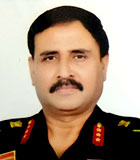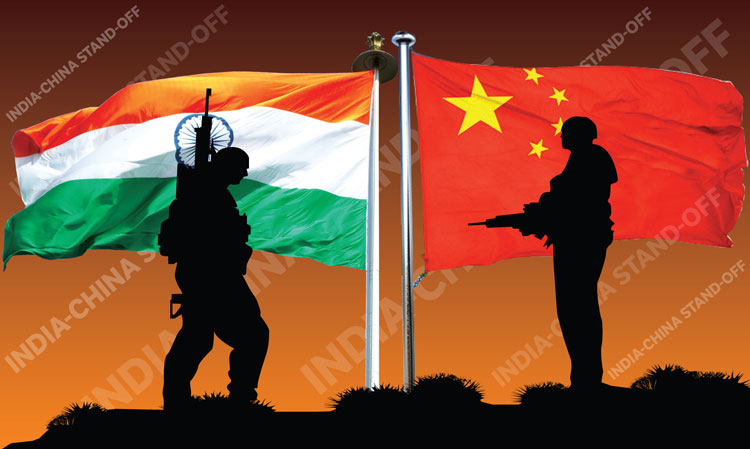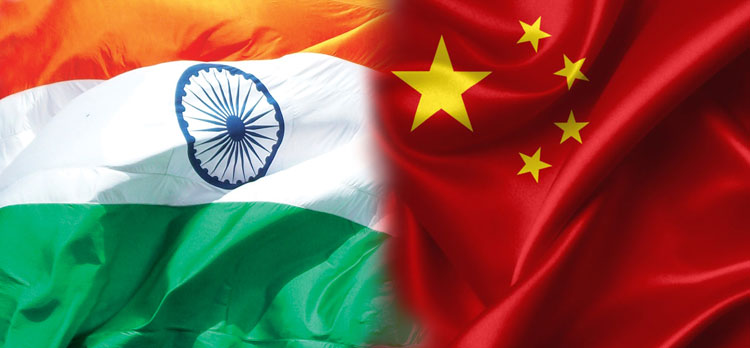INDIAN ARMED FORCES CHIEFS ON
OUR RELENTLESS AND FOCUSED PUBLISHING EFFORTS

SP Guide Publications puts forth a well compiled articulation of issues, pursuits and accomplishments of the Indian Army, over the years

I am confident that SP Guide Publications would continue to inform, inspire and influence.

My compliments to SP Guide Publications for informative and credible reportage on contemporary aerospace issues over the past six decades.
- Interim Defence Budget 2024-25 — An Analysis
- Union Defence budget 2024
- Indian Army: In quest of greater firepower and policy recommendations for gaps
- Indian Army Annual Press Conference 2024
- 6G will transform military-industrial applications
- Tata Boeing Aerospace Delivers 250 AH-64 Apache Fuselages, Manufactured in India
Disengagement or Deceit Again
Throughout their history, China has had brutal conflicts with their neighbours and time and again it has been proven that they cannot be trusted. In an article "Disengagement to Demobilisation", published in issue 2-3, 2020 of SP's Land Forces magazine, the writer had pointed out that in Eastern Ladakh, there is disengagement (thinning out) but not de-escalation (de-mobilisation) making the consequences implicit.
 |
The Author is Former Chief of Staff (COS), Central Command, Indian Army. He is an expert on Siachen and Ladakh with experience in counter insurgency operations in J&K and North East and is also an expert on Information Warfare. |

If at all any one in the South Block even had a distant presumption that the Corps Commander level talks at Moldo on August 2, would have any tangible outcome towards de-escalation, they were living in Utopia. It was another deceit. The meeting point on the Chinese side was chosen because China had sought this meeting, to keep talking, bide the time and cement the recently created situation as new Normal. A situation in which China has gained sizeable territory and ensured that Indian troops cannot patrol the areas that they were doing so far along the 1597 Km long LAC in Eastern Ladakh. The signals of these talks reaching nowhere were visible with the discourse of the Chinese Ambassador to India Sun Weidong and the Foreign Ministry spokesperson. The Chinese Ambassador on 31 July had squarely blamed India for the Galwan clashes, claimed that PLA was on its own side of the “traditional customary Boundary Line” and that China was not in favour of resuming the process of clarifying the LAC because it could “create new disputes.” And this is when China had officially stated on 28 July that the disengagement is complete. In the meantime there were reports of China having moved a battalion of troops in the Central Sector, which is most unusual. Though Barahoti in the Central Sector was the first acknowledged dispute between the two countries in 1954 but for minor routine moment there has never been an active deployment in this area post 1962. Hence the status-quo-ante of pre April 20 will not be restored by China is a fait accompli.
Disputes have been created in areas where we didn’t have an untoward incident for decades, like Finger Areas. Why there should be requirement of any new protocols when we have had 30 years of event free engagement, especially ever since the Peace and Tranquillity Agreement of 1993.
Routine barbs by various Chinese speakers/spokespersons, including the Minister for Foreign Affairs, to indicate as if nothing has happened that should spoil the relations between two big neighbours continue unabated. The Chinese Ambassador while continuing with his accusations of India for the current situation goes on to say that “...It is undoubtedly short-sighted and harmful to deny the long history of peaceful co-existence between China and India and to portray our friendly neighbour for thousands of years as an "opponent" or a "strategic threat" due to temporary differences and difficulties. We should correctly analyse and view each other's strategic intentions, and prevent misinterpretation and miscalculation in a positive, open and inclusive attitude”. He goes on “Pending the final settlement of the boundary question, the two sides should make joint efforts to maintain peace and tranquillity in the border areas.” It is clarified that in their scheme of things and belief there is nothing wrong in whatever China has done and wherever PLA is currently holding positions is all China’s territory and India is the aggressor.
The Foreign Ministry spokesperson Wang Wenbin on August 04 was asked to respond on Indian Foreign Minister recent statement where S. Jaishankar had said that he “believes that reaching an equilibrium with China is not going to be easy. We will be tested and we must stand our ground.” Wang stated that “the two should place the boundary issue in a proper position and make sure that differences do not escalate into disputes.” Amidst the entire belligerence this is nothing but rhetoric and simple plane rhetoric.

Disputes have been created in areas where we didn’t have an untoward incident for decades, like Finger Areas. This also has emerged as the hardest part of the disengagement where India’s claim is up to Finger 8 and China claims up to Finger 4. The distance between Finger 4 to Finger 8 is eight km. As per reports, PLA troops are not only located at Finger 4 but have created permanent defences and moved more forces to the rear of the same in support of troops deployed in front. The deployment and construction shows an element of permanence. This also implies that Indian Army has to be prepared for a long haul further reinforcing their already boosted strength. Our troops may end up being there not for the next winter or the summer after that but even for another decade, if we let the Chinese have their way and don’t capitalise on the aggression that troops on ground have examplified.
On one side China wants Indian Army to pull back from its own territory, patrolling curtailed and convert new positions into reality. On the other, it is moving in more forces as also laying new claims and bringing in new disputes. Far from de-escalation, it is rather belligerence reinforced.
The high powered China Study Group (CSG) met on August 04 to assess the situation after the stalemate in marathon talks at Moldo Garrison on August 02. As per reports, the CSG is considering the steps to be taken on ground to restore the status quo ante of pre April 20 period including consideration of protocols to avoid skirmishes in the future. Why there should be requirement of any new protocols when we have had 30 years of event free engagement, especially ever since the Peace and Tranquillity Agreement of 1993. As long as the two sides respect each others perception of LAC, which is well known to the troops on ground, the situation can be controlled. Reports of such considerations send mixed signals to China and rest of the world that we are ceding ground and may settle with less than status quo. It would give an impression that sacrifices made on ground to ensure the sanctity of the borders are worthless, an unwarranted disrespect.
The dissonance between China’s description of disengagement process being almost complete and India’s claim of PLA troops being on Indian Territory and Chinese narrative of continuing to blame India for all that has happened on LAC brings in more distrust rather than confidence in each other. On one side China wants Indian Army to pull back from its own territory, patrolling curtailed and convert new positions into reality. On the other, it is moving in more forces as also laying new claims and bringing in new disputes. For example, Bhutan has been pulled into the conundrum with a new claim on Sakteng wild life Sanctuary, a 650 km area of forest land in Eastern Bhutan adjoining Kameng and Tawang districts of Arunachal Pradesh. This has no historic or Geographic evidence. Hence far from de-escalation, it is rather belligerence reinforced.
India must respond with equal aggression and deliberated long term strategy. Creative ways must be devised to exert military pressure in those geographical areas where China is weak and shall continue to be so due to terrain friction and force disadvantage.
India must respond with equal aggression and deliberated long term strategy. To begin with, we must boost strength not only in Ladakh but in other areas as well along the LAC selectively. Creative ways must be devised to exert military pressure in those geographical areas where he is weak and shall continue to be so due to terrain friction and force disadvantage. The rhetoric of “placing the boundary issue aside and seek stronger solidarity and cooperation between two largest developing countries and emerging economies to world’s peace and prosperity” should be exposed as much as possible with the existing alliances and forging new ones. We must not forget that a country that regarded itself at the pinnacle of civilisation, and that for nearly two centuries has regarded its uniquely moral and world leadership position to have been usurped by the rapaciousness of Western and colonial powers, cannot be content to limit its strategic goals to cordial relations and build mutual prosperity.
It should be made absolutely clear that boundary dispute is the core issue and no security threat will be entertained. While cementing international partnership as the QUAD, we should participate in global narration against China. The anger and dismay that has come about against China in the country must reverberate so that it does not get away with idea that he can do business as normal. The conviction of our population will generate its own momentum. There should be no let up on the economic offensive that has been launched and steps taken to implement at home and gather the support from the alliances manifesting in a cascading impact. China will only back track, if it does, when it is entangled and strangled economically and would feel the heat across all domains. And while engaging externally, internal harmony is essential. There are large number of domestic issues including the sagging economy which need to be handled with diligence and prudence.
The situation also offers a great opportunity to reflect on issue of structures which were recommended by the Kargil review Committee and the Group of Ministers headed by no less than L.K. Advani on which volumes have been written subsequently, however, allowed to gather dust. Integrated efforts in intelligence domain, force application/joint operations, procurement process of defence equipment, and above all self sufficiency in defence production must get holistically addressed. India as a country and as people must understand and acknowledge the importance of National Security without which moral purpose operates in a vacuum.





